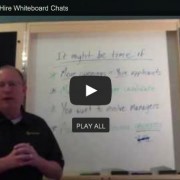5 Signs You Need to Automate Your Hiring Process
Has your hiring process grown unmanageable? Evolving technology, burgeoning job sites, a shrinking labor pool and the widening skills gap are just a few of the reasons hiring is a lot tougher than it used to be.
If you’re receiving resumes in your email or logging into each job board individually, you’re spending even more time hiring candidates. And, as if hiring wasn’t a towering task already, not hiring effectively can have damaging effects down the road.
If hiring the right candidate has ballooned into an HR headache, streamlining your hiring process may help. In this article, we’ve compiled 5 signs you need to automate your hiring process.
You Don’t Know Your Recruitment Metrics
Understanding your recruitment data is the first step to taming your hiring process. The best applicant tracking systems can help you easily access the most important metrics. Below are some common recruitment metrics you should know:
- Time-to-hire is calculated by counting the number of days between a candidate applying for your position and accepting the job. Learn how effective the changes you make to the hiring process really are by benchmarking this number.
- Cost-per-hire is the sum of external and internal hiring costs divided by the number of new hires in the same time frame. Your cost per hire may be more useful if you calculate it for type of positions, e.g., you expect to spend more to hire a mid-level manager than you would an entry-level employee.
- New hire turnover rate is the percentage at which new employees leave within a given period of time–you can decide what qualifies as “new” based on your organization, but many consider it to be under one year. By looking at how frequently new hires leave and why, you can uncover ways to improve both your hiring and onboarding processes.
- Retention rate is the percentage of employees staying with the company over a given time period. Calculate retention rate by dividing the number of employees remaining in the company or department by the total number of employees present at the beginning of the time period being measured.
- Job application completion rate can tell you how often job seekers complete your application, and it can reveal whether changes need to be made to your online job application. Reducing the number of abandoned applications (or your applicant drop-off rate) will improve your hiring success.
A hiring process overrun with manual processes is difficult to measure. Automating your hiring process can help you track its effectiveness.
You Need to Reduce Your Time-to-Hire
Time-to-hire varies widely across industries. According to DHI Group, hiring in the health services takes 49 days, while construction industry’s time-to-hire is the shortest at about 12 days. Whether your time-to-hire is longer than your industry’s average, or you just want to shorten it to avoid lost productivity, automating your hiring process can help fill those empty chairs more quickly.
Here are some ways applicant tracking systems can reduce your company’s time-to-hire:
- Automate time-consuming tasks. Logging into multiple job sites individually to post the same job is slow work. And it takes even longer if you push tedious tasks like this to the bottom of your list. Post your job opening with a click of a button to multiple sites at once.
- Adopt mobile recruiting. You can speed up the application process for your candidates by adopting mobile recruiting methods. A mobile-friendly application brings the candidate to you more quickly. And text messaging avoids voicemail delays. You can further simplify the recruiting process by inviting applicants to apply with their phone number or by using a QR code on print or other display media.
- Use programmatic job advertising. Don’t wait for top talent to come to you. Use programmatic job advertising to put your job ad on the same sites your top candidates visit.
You Need to Hire Better Quality Candidates
Your recent new hires have been disappointing. They seemed qualified, but six months on the job and they still seem lost in the software. They interviewed so well, but after their first run-in with a customer, you can see they’re lacking soft skills. Whatever it was that made you hire them turned out to just be a mirage.
Automating your hiring process with an applicant tracking system can help you make better hiring decisions. Here are a few ways automation can help:
- See the best candidates first. An applicant tracking system can use your application and the candidate’s resume to rank applicants. The most qualified applicants will go to the top of your list.
- Create deal-breaker questions on your application. Willing to work weekends? Certification updated? Reliable transportation? Whatever the dealbreaker, start screening for it right away. An applicant tracking system can automatically filter out candidates with dealbreaker traits.
- Use assessment tools. Peel away the polished interview skills and test the resume claims with assessment tools. From people skills to software proficiency, assessment tools can uncover a candidate’s real traits.
You Hire for a High-Turnover Industry
Some industries just have high turnover. Hospitality and retail are notorious for their low retention rates. For some job seekers, these jobs may be seen as steppingstones to higher paying jobs. Even after improving your employer brand and doing what you can to increase engagement, the nature of these jobs means you’re always hiring.
You can make your hiring process more efficient and still have time for other, pressing HR responsibilities by automating these hiring tasks:
- Use message templates. Write messages once and send them automatically to applicants. The ATS will fill in the applicant’s name and other details to personalize the message. Save time by letting the ATS automatically send interview requests, rejection letters, and receipt of application confirmations.
- Conduct initial interviews by text. An applicant tracking system can make interviewing by text easier and safer. Interviewing by text saves time. And by using an ATS, hiring managers don’t need to use their personal cell numbers, and the text conversation is automatically documented and saved.
- Schedule interviews more easily. Sometimes, there’s a bit of back and forth when it comes to interview scheduling. You can automate the interview scheduling process with an applicant tracking system. The system will integrate with your calendar. You can send the candidate multiple choices for interview times. If the candidate needs to reschedule, he can just click on a link in the confirmation email.
Increasing HR Responsibilities Leave Less Time for Manual Processes
Once upon a time, human resource professionals spent most of their time hiring, managing benefits, and increasing workplace safety. Not anymore. Today, companies understand that employees are their most important asset. They know that having a healthy company culture, strong employer brand, and highly engaged employees increases their bottom-line.
Of course, these workplace values make working in human resources more exciting and more rewarding than ever. But the work of developing those workplace assets falls on human resources. If increasing HR responsibilities are leaving you little time to make high quality hiring decisions, then automating your hiring process may help.
There are probably a dozen reasons the hiring process has become unmanageable. If the increasing chaos of the recruitment process leaves you little time for calculating recruitment metrics, much less time to improve them, an applicant tracking system can improve your results. Automating recruitment tasks will leave you time for finding creative solutions to your pressing HR issues.
Are you interested in learning how automating your hiring process with applicant tracking software can improve your recruitment outcomes? Contact ExactHire today.
Photo by Riccardo Annandale on Unsplash








